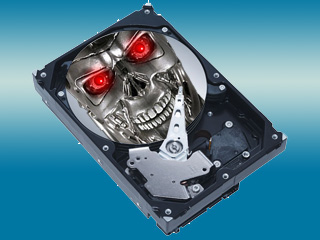 You Are Your Data
You Are Your Data
When it goes, you go…
What would happen if you forgot your printout of the presentation, or the notes you planned to use for an important meeting? You’d call the office to have someone email or messenger it to you. What if you realized you left your briefcase in the cab, on the train, or somewhere that it might not make it back to you? It might be gone for good, but you can always go back to your computer to print out what you need.
What if you turn on your computer and… nothing happens? Your hard drive is dead. That’s like losing a lifetime of briefcases. One thing you can be sure of, a worst-case like this will hammer home just how many hours of work you have stored on a small, mechanical device that can suddenly stop without warning. And (apologies to The Terminator) “It can’t be bargained with. It can’t be reasoned with. It doesn’t feel pity, or remorse, or fear. And it absolutely will not (work), ever, until you are (toast).”
If you’ve made a backup of your hard drive, a data loss event like this will be meaningless. You’ll have a complete copy of your data, restore it to a new hard drive, and you’re back in business. If you don’t have a backup, you’ll be in the midst of a stressful situation unlike anything you might have expected. A backup is the “last line of defense” against data loss. When everything else fails, you can rely on your backup to put your digital world back together.
Do you have a backup of ALL your data? Actually, most people don’t. Typically, people make copies of things they feel are important, but if the worst-case occurs, it can still take hours or even days to reconstruct the working data needed. A business can fail for lack of a simple backup.
And according to the conventional wisdom of sites like Wikipedia, backups, by nature, tend to be “the least granular and among the least convenient to use.”
I disagree. Here is how I follow a Backup Strategy that’s totally effective as that last line of defense, and here’s how I do it simply and easily:
- Understand that this Backup Strategy is meant strictly for the worst-case event, it’s not intended to be a way to go back to earlier versions of corrupted or accidently deleted files, although in some cases it can work for this scenario too
- I matched my computer’s internal drive with an external that’s identical in size. I have a 250 gigabyte internal drive, so I bought and connected a 250 gigabyte external hard drive
- At some point every weekend I simply copy my entire internal hard drive to my external drive. If my hard drive fails, I have everything duplicated, and at worst, I’ll lose only one week’s worth of data.
A backup is only as good as the ease in which it can be made, so the easier it is, the more likely you’ll take the weekly steps to make the backup.
(Now, the “notes and comments”: Yes, I KNOW there are dozens of other ways, and scores of other apps to automate your backups. Yes, absolutely, buy one and use it! And I also know there are archiving and restoration apps that people swear by, or swear at… this is not about comparing and contrasting. This is for anyone who simply has NO backup strategy at all. A 250 gigabyte external hard drive costs about $100, and even if you only make the backup every month, or every six weeks, you’ll still HAVE a backup! And that’s the point.)
I use a very simple program on the Mac – it’s called “SuperDuper” and it’s designed to do exactly the strategy I suggest above. I run it once each week, always on the weekend (it’s my way to remember to do it – if it’s the weekend, I have to make a backup). SuperDuper simply takes only the files that have been created or changed each week and backs them up. My weekend backups take about 10 minutes. Once when an update to my operating system seriously corrupted my hard drive, I used SuperDuper to copy everything from the external drive back onto the internal drive. I was back in business in about an hour without enduring any stress at all.
If you don’t have a backup of your hard drive, someday you’ll wish you did. Make a one-time buy of a “mirror” drive, use it only as a backup of your regular drive, and keep it up to date by making that backup on a schedule that works for you.
Here’s the link to SuperDuper for the Mac:
http://www.shirt-pocket.com/SuperDuper/SuperDuperDescription.html
Here’s the link to Drive Snapshot for Windows:
http://www.drivesnapshot.de/en/
Enjoy! (And be proactive: Backup regularly!)
–Marc
February 4, 2008 @ 10:00 PM

